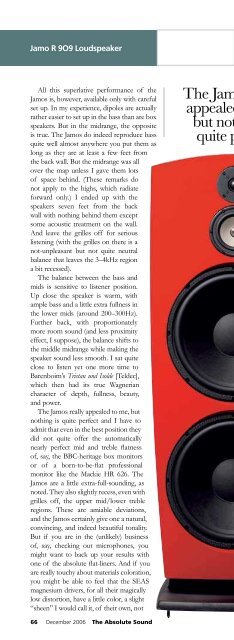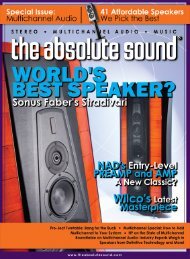Create successful ePaper yourself
Turn your PDF publications into a flip-book with our unique Google optimized e-Paper software.
Jamo R 9O9 Loudspeaker<br />
All this superlative performance of the<br />
Jamos is, however, available only with careful<br />
set up. In my experience, dipoles are actually<br />
rather easier to set up in the bass than are box<br />
speakers. But in the midrange, the opposite<br />
is true. The Jamos do indeed reproduce bass<br />
quite well almost anywhere you put them as<br />
long as they are at least a few feet from<br />
the back wall. But the midrange was all<br />
over the map unless I gave them lots<br />
of space behind. (These remarks do<br />
not apply to the highs, which radiate<br />
forward only.) I ended up with the<br />
speakers seven feet from the back<br />
wall with nothing behind them except<br />
some acoustic treatment on the wall.<br />
And leave the grilles off for serious<br />
listening (with the grilles on there is a<br />
not-unpleasant but not quite neutral<br />
balance that leaves the 3–4kHz region<br />
a bit recessed).<br />
The balance between the bass and<br />
mids is sensitive to listener position.<br />
Up close the speaker is warm, with<br />
ample bass and a little extra fullness in<br />
the lower mids (around 200–300Hz).<br />
Further back, with proportionately<br />
more room sound (and less proximity<br />
effect, I suppose), the balance shifts to<br />
the middle midrange while making the<br />
speaker sound less smooth. I sat quite<br />
close to listen yet one more time to<br />
Barenboim’s Tristan und Isolde [Teldec],<br />
which then had its true Wagnerian<br />
character of depth, fullness, beauty,<br />
and power.<br />
The Jamos really appealed to me, but<br />
nothing is quite perfect and I have to<br />
admit that even in the best position they<br />
did not quite offer the automatically<br />
nearly perfect mid and treble flatness<br />
of, say, the BBC-heritage box monitors<br />
or of a born-to-be-flat professional<br />
monitor like the Mackie HR 626. The<br />
Jamos are a little extra-full-sounding, as<br />
noted. They also slightly recess, even with<br />
grilles off, the upper mid/lower treble<br />
regions. These are amiable deviations,<br />
and the Jamos certainly give one a natural,<br />
convincing, and indeed beautiful tonality.<br />
But if you are in the (unlikely) business<br />
of, say, checking out microphones, you<br />
might want to back up your results with<br />
one of the absolute flat-liners. And if you<br />
are really touchy about materials coloration,<br />
you might be able to feel that the SEAS<br />
magnesium drivers, for all their magically<br />
low distortion, have a little color, a slight<br />
“sheen” I would call it, of their own, not<br />
66 December 2006 The Absolute Sound<br />
The Jamos really<br />
appealed to me,<br />
but nothing is<br />
quite perfect<br />
obvious and not disagreeable, but audible<br />
with enough exposure. Still, talk about picking<br />
nits on a wonderful product—overall, the<br />
Jamos give so much of the truth and beauty<br />
and strength of real music that one’s critical<br />
faculties are all but disarmed.<br />
Jamo has been a well-established brand in<br />
Europe for a long time. But has not been<br />
a major presence in the U.S. until now.<br />
From here on out, though, they should<br />
be a high-end force to be reckoned<br />
with. The Jamo R 909s are poised to<br />
become a legend in their own time.<br />
And they deserve it. I haven’t had such<br />
a good time with a review sample in a<br />
month of Sundays. TAS<br />
<strong>Specs</strong><br />
& <strong>Pricing</strong><br />
JAMO U.S.<br />
3502 Woodview Trace, Suite 200<br />
Indianapolis, Indiana 46268<br />
(877) 878-JAMO<br />
support@jamo.com<br />
jamo.com<br />
Type: Three way baffled dynamic driver<br />
dipole (monopole treble)<br />
Driver complement: Two 15" woofers; one<br />
5" SEAS magnesium midrange;<br />
one 1" Scanspeak Revelator tweeter<br />
Frequency response: 25Hz–30kHz<br />
Sensitivity: 89dB<br />
Nominal impedance: 4 ohms<br />
Dimensions: 21" x 50.2" x 19"<br />
Weight: 139 lbs.<br />
Price: $14,999<br />
ASSOCIATED EQUIPMENT<br />
Nakamichi TX1000 turntable; Morch DP-6<br />
tonearm; Bang and Olufsen MMC1 cartridge;<br />
Classé Audio CD-1 transport and DAC-1<br />
converter, Benchmark DAC1 converter; Plinius<br />
and Bryston BP-25 preamplifiers; Z Systems<br />
RDP-1 and RDQ digital preamplifiers/ EQ<br />
devices; Bryston 14 B ST and Carver A-220<br />
amplifiers; Harbeth Monitor 40 and Gradient<br />
1.3 loudspeakers; Audio Physic Minos<br />
subwoofer; Liberty Audio Suite and Liberty<br />
Praxis measurement systems










